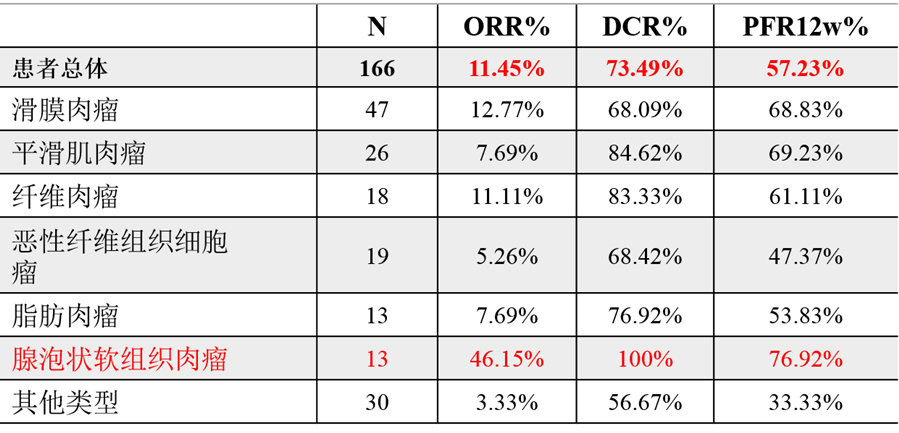医脉通编译整理,转载请务必注明出处。
2016年6月3日-7日,美国临床肿瘤学会(ASCO)2016年会在美国芝加哥盛大召开。本次大会中国学者取得了口头报告新突破:大陆有4项入选,台湾有3项入选。当地时间6月5日上午肉瘤专场,来自中国医学科学院肿瘤医院的依荷芭丽·迟教授口头报告了一项Ⅱ期临床研究,评价了国产靶向药物安罗替尼治疗晚期软组织肉瘤的疗效和安全性(Abstract No:11005)。
化疗失败的难治性软组织肉瘤患者预后差,现阶段没有标准治疗方案可供选择。安罗替尼是中美共同研发,具有自主知识产权的多靶点受体酪氨酸激酶抑制剂,可靶向VEGFR1/2/3、FGFR1/2/3、FDGFRα/β、c-Kit、Ret等。前期临床研究发现该药对包括甲状腺癌、肺癌、软组织肉瘤、肾癌在内的多种实体瘤具有一定疗效。
摘要编号:11005
时间:6月5日,上午8:00-11:30
报告形式:口头报告
主要研究内容
软组织肉瘤患者主要入组标准:
◆年龄18-70岁
◆疾病晚期且常规治疗失败,无脑转移和脊髓压迫
◆组织学类型为恶性纤维组织细胞瘤、脂肪肉瘤、平滑肌肉瘤、滑膜肉瘤和其他类型(恶性周围神经鞘膜瘤、纤维肉瘤、透明细胞肉瘤、腺泡状软组织肉瘤、血管肉瘤、上皮样肉瘤)
◆至少接受过一种化疗方案治疗
◆按照RECIST 1.1标准有可测量病灶
◆ECOG PS 0-2
◆期望寿命>3个月
◆骨髓造血、肝肾功能耐受
◆在研究中及研究后6个月内避孕
◆未曾接受EGFR TKI治疗
自2013年4月至2015年5月,研究入组166例晚期软组织肉瘤(STS)患者。其中男性100例,女性66例。
组织学类型包括滑膜肉瘤(SS)47例,平滑肌肉瘤(LMS)26例,恶性纤维组织细胞瘤(MFH)19例,纤维肉瘤(FS)18例,脂肪肉瘤(LS)13例,腺泡状软组织肉瘤(ASPS)13例,其他类型合计30例。排除特殊生物学特性的软组织肉瘤和骨、软骨肉瘤。
安罗替尼治疗周期为三周,12mg/d连续两周,休息一周。
主要终点是12周时的疾病无进展率(Progression-free Rate, PFR12w),次要终点是客观缓解率(ORR)、无进展生存(PFS)、总生存(OS)和安全性。
主要研究结果
该研究共154例患者可评估疗效,PFR12w为57.23%,中位PFS为5.63个月。

如上表所示,患者完全缓解率(ORR)=11.45%,其中腺泡状软组织肉瘤疗效最为明显。
所有患者均耐受安罗替尼,常见的3-4级不良反应(AE)包括:高血压(8)、气胸(5)、甲状腺功能低下(2)、蛋白尿(1)、手足皮肤反应(1)、腹泻(1)、甘油三脂升高(2)、高糖血症(1)。
治疗过程中有24例(14.5%)患者接受剂量调整,安罗替尼每日剂量调低至10mg/d,治疗周期不变。
结论
该研究集合了全国15家医疗单位的努力。从治疗效果来看,安罗替尼在多种组织类型的STS中均表现出一定的临床疗效,尤其是滑膜肉瘤和腺泡状软组织肉瘤。此外,安罗替尼的毒副作用耐受性良好,但需要注意气胸的发生风险。
会议专题》》》2016年ASCO年会专题报道
摘要阅读
Abstract No:11005
PhaseII study of anlotinib for treatment of advanced softtissues sarcomas
Session: Sarcoma
Type: Oral Abstract Session
Author(s): Yihebali Chi, YongkunSun, Jianqiang Cai.et al.
Background: No standard therapiesare available in China for Soft tissues sarcomas (STS) patients who failed tochemotherapies. Anlotinib is a multi-target RTK inhibitor, with VEGFR1/2/3,FGFR1/2/3, PDGFRα/β, c-Kit, Ret ect. Recommended dose in phase I is 12 mgdaily, 2 weeks on/1 week off. This single-arm, multi-center phase II study(NCT01878448) to assess efficacy and safety of Anlotinib for treatment of STSpatients who failed to conventional therapies.
Methods: Pathologicaltypes of advanced STS mainly include malignant fibrous histiocytoma (MFH), liposarcoma,leiomyosarcoma, synovial sarcoma (SS) and other sarcomas, but excluding RMS,chondrosarcoma, GIST etc. Patients with measurable indicators (RECIST1.1) weretreated with Anlotinib. Efficacy was assessed every 6 weeks. The primaryendpoint was disease PFR at week 12 (PFR12w ).
Results: FromApril 2013, we recruited 166 patients in 15 centers in China, including 100males and 66 females, average age is 44 (15-70). Pathological types included SS(n=47), leiomyosarcoma (n=26), fibrosarcoma (n=18), MFH (n=19), alveolar softpart sarcoma (ASPS, n=13), liposarcoma (n=13), others (n=30). As ofMay 2015, 154 patients were assessable for efficacy: PFR12w was 57.23%,mPFS was 5.63 months.22 patients achieved PR over time (19 pts confirmed, andORR was 11.45%. See below table. 166 patients were assessable for safety.Common grade III/IV AEs include: hypertension(n=8), pneumothorax(n=5), thyroidhypofunction(n=2), proteinuria(n=1), hand-foot-skin reaction(n=1),diarrhea(n=1), triglyceride increase (n=2), hyperglycemia (n=1). 24 patients(14.5%) had dose adjustment during treatment, reducing to 10 mg daily, 2 weekson/1 week off.
Conclusions: Anlotinib iseffective to many pathological types of soft tissue sarcoma, particularly toASPS and SS. Overall PFR12w reached 57.23%. Meanwhile, Anlotinib is welltolerated, while pneumothorax needs to be noticed. A randomized, controlledclinical trial is ongoing. Yihebali Chi and Sun Yongkun contributed equally tothis work. Clinical trial information:NCT01878448.
打开微信 →→ 添加“医脉通肿瘤科”公众号,或扫描电脑屏幕右上方二维码 →→ 关注医脉通肿瘤科。随时随地获取肿瘤前沿资讯,一次打包最实用的肿瘤治疗知识。做科研达人、临床高手,尽在医脉通肿瘤频道。
